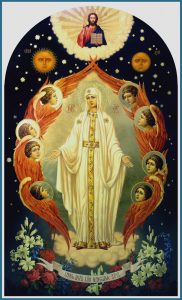 Neither the tomb, nor death, could hold the Theotokos, who is constant in prayer and our firm hope in her intercessions. For being the Mother of Life, she was translated to life, by the One who dwelt in her virginal womb (Kontakion for the Dormition).
Neither the tomb, nor death, could hold the Theotokos, who is constant in prayer and our firm hope in her intercessions. For being the Mother of Life, she was translated to life, by the One who dwelt in her virginal womb (Kontakion for the Dormition).
As part of our celebration of Dormition on Tuesday, August 15, we will bless herbs and flowers for use in the home. Please bring herbs and flowers to Divine Liturgy (10:00 a.m. and at 7:00 p.m.). As a point of liturgical fact, the Church asks God to bless herbs and flowers –and thus us– to remind all of us of the gifts God has given us for our sustenance, healing and beauty.
Holy Tradition educates us that all the Apostles, except St. Thomas who was late, were transported mystically to Jerusalem in order to be with the Mother of God – the Theotokos – as she reposed, and to given her a burial. When Thomas arrived the next day, the Apostles opened the tomb so that he could kiss Mary farewell. The opened tomb revealed that the body of the holy Virgin of Mother of God was missing, and filled with herbs and flowers. This event was a sure sign of her great purity and holiness.
What happens to Mary happens to all of us who imitate her holy life of humility, obedience, and love.
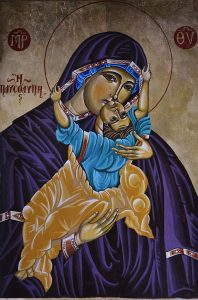 In addition to the myriad of feast days honoring Our Lady in her many titles and virtues, the entire month of May is especially given to her praise. In the words of Pope Paul VI: May is “a month which the piety of the faithful has long dedicated to Mary, the Mother of God . . . For this is the month during which Christians, in their churches and their homes, offer the Virgin Mother more fervent and loving acts of homage and veneration; and it is the month in which a greater abundance of God’s merciful gifts comes down to us from our Mother’s throne.”
In addition to the myriad of feast days honoring Our Lady in her many titles and virtues, the entire month of May is especially given to her praise. In the words of Pope Paul VI: May is “a month which the piety of the faithful has long dedicated to Mary, the Mother of God . . . For this is the month during which Christians, in their churches and their homes, offer the Virgin Mother more fervent and loving acts of homage and veneration; and it is the month in which a greater abundance of God’s merciful gifts comes down to us from our Mother’s throne.”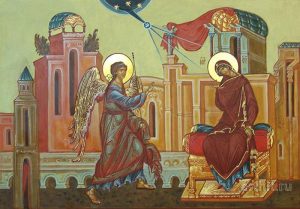 This weekend we are celebrating the mystery of our Lord’s accepting human nature for our salvation. The Archangel Gabriel asks Mary to receive God’s plan and become the mother of the Son and Word of God, to be named “Jesus,” “Savior.” Mary replies, “Behold, I am the handmaid of the Lord. May it be done to me according to your word. (Luke 1:38)” Mary’s response to God was perfect and reversed the sin of Eve. In our Lenten journey, we
This weekend we are celebrating the mystery of our Lord’s accepting human nature for our salvation. The Archangel Gabriel asks Mary to receive God’s plan and become the mother of the Son and Word of God, to be named “Jesus,” “Savior.” Mary replies, “Behold, I am the handmaid of the Lord. May it be done to me according to your word. (Luke 1:38)” Mary’s response to God was perfect and reversed the sin of Eve. In our Lenten journey, we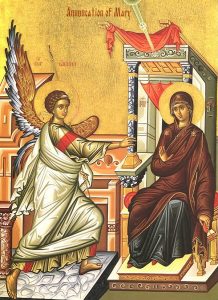 Annunciation of Mary, the Mother of God (Theotokos), March 25th
Annunciation of Mary, the Mother of God (Theotokos), March 25th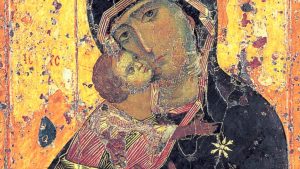 The following meditation opens an interesting question about Mary, the Mother of God (Theotokos means the bearer of God). A daughter of an Orthodox priest, Sister Vassa, a native of Nyack, NY, earned a doctorate in liturgical theology from the Pontifical Oriental Institute, Rome, now is a researcher and teacher in Vienna. She produces a the popular program, “Coffee with Sister Vassa.”
The following meditation opens an interesting question about Mary, the Mother of God (Theotokos means the bearer of God). A daughter of an Orthodox priest, Sister Vassa, a native of Nyack, NY, earned a doctorate in liturgical theology from the Pontifical Oriental Institute, Rome, now is a researcher and teacher in Vienna. She produces a the popular program, “Coffee with Sister Vassa.”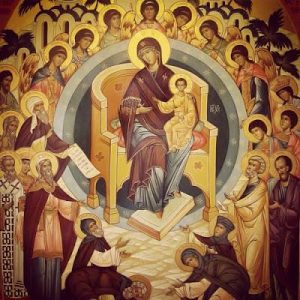 Today, the day after the Christmas feast the Byzantine Church honors Mary, the Mother of God (Theotokos) with a special feast day of remembrance.
Today, the day after the Christmas feast the Byzantine Church honors Mary, the Mother of God (Theotokos) with a special feast day of remembrance.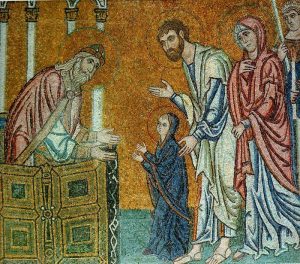 “The most pure Temple of the Savior; / the precious Chamber and Virgin; / the sacred Treasure of the glory of God, / is led today into the house of the Lord. / She brings with her the grace of the Spirit, / therefore, the angels of God praise her: / ‘Truly this woman is the abode of heaven.’” (Kontakion-Hymn of the Entry of the Theotokos into the Temple)
“The most pure Temple of the Savior; / the precious Chamber and Virgin; / the sacred Treasure of the glory of God, / is led today into the house of the Lord. / She brings with her the grace of the Spirit, / therefore, the angels of God praise her: / ‘Truly this woman is the abode of heaven.’” (Kontakion-Hymn of the Entry of the Theotokos into the Temple)